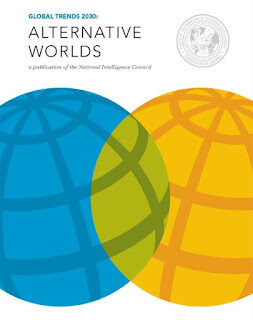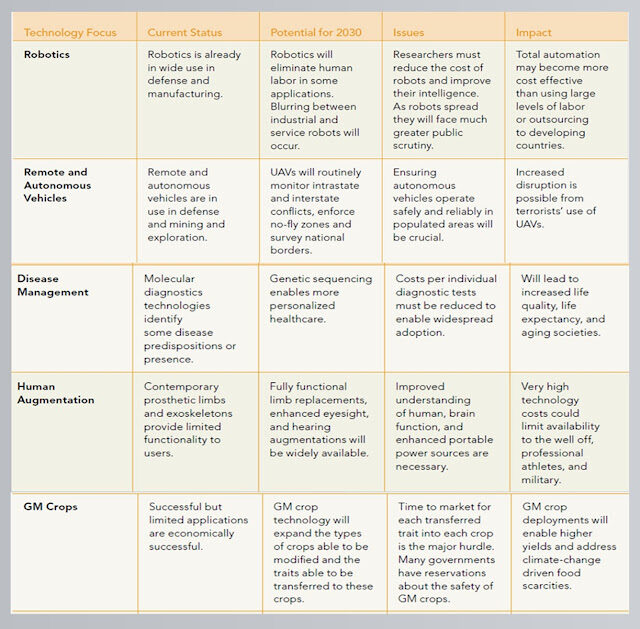Brain-machine interfaces could provide “superhuman” abilities… The high cost of human augmentation means that it probably will be available in 15-20 years only to those who are able to pay. Such a situation may lead to a two-tiered society…
Moral and ethical challenges to human augmentation are inevitable.
—National Intelligence Council
The National Intelligence Council published its Global Trends 2030: Alternative Worlds a publication of the National Intelligence Council. Here are some highlights.
“Human Augmentation”
Spanning a wide gamut of technologies, ranging from implants and prosthetics to powered exoskeletons, human augmentation enhances innate human abilities, or replaces missing or defective functions such as damaged limbs…Brain-machine interfaces in the form of brain-implants are demonstrating that directly bridging the gap between brain and machine is possible. Military organizations are experimenting with a wide range of augmentation technologies, including exoskeletons that allow personnel to carry increased loads and sychostimulants that allow personnel to operate for longer periods.
Human augmentation could allow civilian and military people to work more effectively…Elderly people may benefit from powered exoskeletons…Successful prosthetics probably will be directly integrated with the user’s body. Brain-machine interfaces could provide “superhuman” abilities, enhancing strength and speed, as well as providing functions not previously available.
As replacement limb technology advances, people may choose to enhance their physical selves…Future retinal eye implants could enable night vision, and neuro-enhancements could provide superior memory recall or speed of thought. Neuro-pharmaceuticals will allow people to maintain concentration for longer periods of time or enhance their learning abilities.
Augmented reality systems can provide enhanced experiences of real-world situations. Combined with advances in robotics, avatars could provide feedback in the form of sensors providing touch and smell as well as aural and visual information to the operator.
Owing to the high cost of human augmentation, it probably will be available in 15-20 years only to those who are able to pay for it. Such a situation may lead to a two-tiered society of an enhanced and non-enhanced persons and may require regulation…Moral and ethical challenges to human augmentation are inevitable.
“Game-Changer 5: The Impact of New Technologies”
New manufacturing and automation technologies such as additive manufacturing (3D printing) and robotics have the potential to change work patterns in both the developing and developed worlds.
“Game-CHANGER 1”
The Crisis-Prone Global Economy
The development of robotics and other emerging advanced manufacturing technologies is also likely to eliminate many jobs in the short-to-medium term.
“Game-CHANGER 2”
Bots—programs that run automated tasks in the Internet-connected world…could manage complex and persistent tasks on behalf of individuals and networked groups.
“Robotics”
Robots have better sensory and mechanical capabilities than humans do, making them ideal for routine tasks. Industrial robots have transformed many manufacturing environments; over 1.2 million industrial robots are already in daily operation around the world…Developers are extending the capabilities of robots, crossing the boundary between industrial robots and nonindustrial robots. Although much development is still required to improve robots’ cognitive abilities, many of the building blocks for futuristic and highly disruptive systems could be in place by 2030…
The military is expected to increase its use of robots to reduce human exposure in high-risk situations and environments as well as the number of troops necessary for certain operations…
Health-care and elder-care robots will become more autonomous and be able to interact with humans. However, they will be able to perform only specialized functions such as surgical support or certain tasks to assist with daily living. Robotics addresses some of the impacts of an aging society, but in the next 20 years the effect is likely to be most pronounced in specific countries like Japan and South Korea…
Technology development is the biggest single constraint for nonindustrial robotics, because researchers must overcome major barriers in the development of robots’ intelligence, including their understanding of the world around them, coping with unanticipated events, and interacting with humans…a new generation of developers and enthusiasts may be able to construct new robotic products, some with potentially dangerous capabilities….Health-care and elder-care robots will become more autonomous and be able to interact with humans. However, they will be able to perform only specialized functions…Autonomous vehicles could transform military operations, conflict resolution, transportation, and geo-prospecting, while simultaneously presenting novel security risks that could be difficult to address…By 2030, UAVs [Unmanned Aerial Vehicles] could be in common use to monitor intrastate and interstate conflicts, enforce no-fly zones, or survey national borders. Low-cost UAVs with cameras and other types of sensors could support wide-area geo-prospecting, support precision farming, or inspect remote power lines…
Self-driving cars could…improve individuals’ productivity (by allowing drivers the freedom to work through their commutes)…Nevertheless, more disruption could result from terrorists’ use of civilian UAVs as platforms to deliver explosives or unconventional weapons…Autonomous vehicles could transform military operations, conflict resolution, transportation, and geo-prospecting, while simultaneously presenting novel security risks that could be difficult to address.
“Disease Management”
Today, physicians struggle to differentiate between many illnesses with similar symptoms…Consequently, diagnostic and pathogen-detection devices will be key enabling technologies for disease management; the future accuracy of molecular diagnostics has the power to transform medicine.
The targets of molecular diagnostics include genetic information…One enabling technology, DNA sequencing, is advancing rapidly with some techniques currently capable of reading a human genome…Molecular diagnostic devices will revolutionize medicine by providing a rapid means of testing for both genetic and pathogenic diseases during surgeries…Advances in synthetic biology will likely result in production facilities making novel treatments and diagnostics agents…replacement organs, such as kidneys and livers, could be developed by 2030…The new disease management technologies will increase the longevity and quality of life for the world’s aging population…
~~~~~~~~~~~~~~~~~~~~~~~~
Due to robo-spaming, I had to close the comment sections. However, you can comment on my Facebook page.
I have to pay for server usage and have made all content on this website free and always will. I support my family on one income and do research, writing, videos, etc. as a hobby. If you can even spare $1.00 as a donation, please do so: it may not seem like much but if each person reading this would do so, even every now and then, it would add up and really, really help out. Here is my donate/paypal page.
Twitter: # transhumanism , #robots, #NWO
Facebook: # transhumanism , #robots, #NWO


